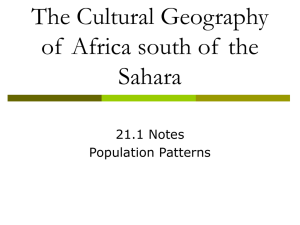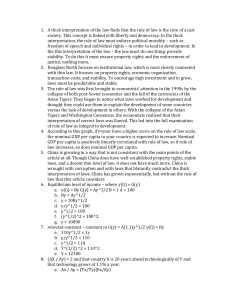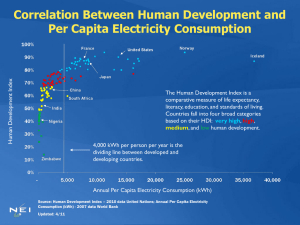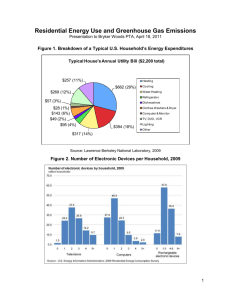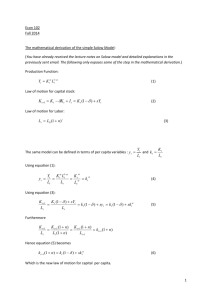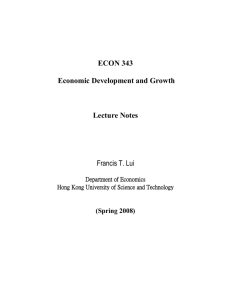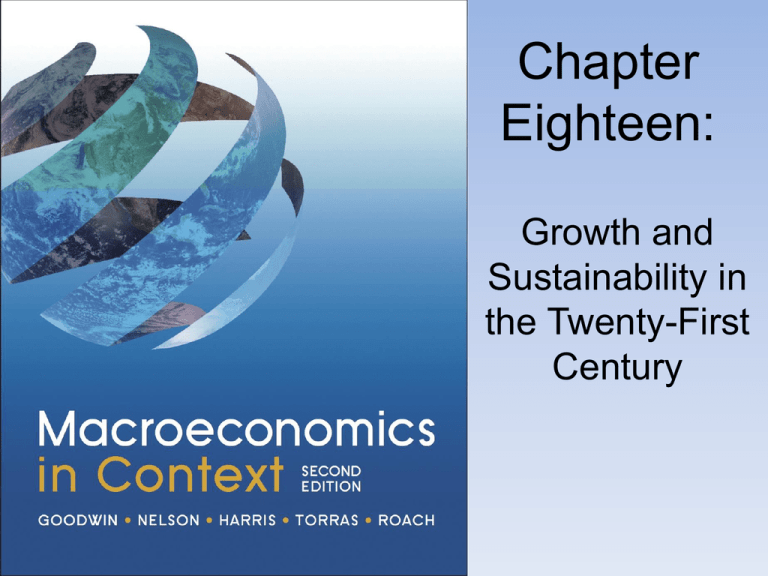
Chapter
Eighteen:
Growth and
Sustainability in
the Twenty-First
Century
Climate Change
Figure 18.1: Global Temperature Trends, 19002100
Source: U.S. Global Change Research Program, www.globalchange.gov .
Economic Growth and the
Environment
Sulfur dioxide emissions per capita (kg)
Sulfur dioxide
per capita (kg)
Kgemissions
S02 per Capita
Figure 18.2: Environmental Kuznets Curve for
Sulfur Dioxide Emissions
250 200 150 100 50 00
5000
10000
15000
$ GNP per Capita
capita
GNPGNP
per per
capita
20000
25000
Source: T. Panayotou, “Empirical Tests and Policy Analysis of Environmental Degradation at Different Levels of Development,” International Labour Office Working Paper,
1993.
Figure 18.3: Carbon Dioxide Emissions vs GDP per
Capita, 2009
25.0
CO2 Emissions per Capita (Metric Tons)
Brunei
United Arab Emirates
Bahrain
20.0
United States
Saudi Arabia
Kazakhstan
15.0
Norway
10.0
China
Switzerland
5.0
Sweden
India
Gabon
-
5,000
10,000
15,000
20,000
25,000
30,000
GDP per Capita (2005 $, PPP)
Source: World Bank, World Development Indicators Database 2013.
35,000
40,000
45,000
50,000
Figure 18.4: Environmentally Based Taxes as a Share
of Total Tax Revenue, Select Industrialized Countries
Percent of total tax revenue
12
10
8
6
4
2
0
Source: OECD, OECD/EEA Instruments Database 2007
Table 18.1: Global Population Classification by
Income and Environmental Impacts, 2013
Source: World Bank, Little Green Data Book 2013; World Development Indicators 2013.
Figure 18.5: A Consumption Possibilities Frontier
Leisure
Europe
United States
Income, Consumption
Are Stabilization and
Sustainability in Conflict?
Figure 18.6: Growth Reaching a Steady-State
Resource-using
Economic Activities
Steady State
Time
Figure 18.7: A No-Growth Scenario for the
Canadian Economy
Index (2005=100)
200
GDP/Capita
150
100
GHG
Unemployment
Poverty
Debt to GDP
50
0
2005
2010
2015
2020
2025
2030
2035
Year
Source: Adapted from Peter Victor, Managing Without Growth: Slower by Deisgn, not Disaster. Northampton, MA: Edward Elgar, 2008, p. 182.
Appendix: Demographic
Challenges
Table 18.2: Stages of Demographic Transition
Figure 18.8: Population by Age and Sex, United
States, 1900, 2000, and 2040 (projected)
(a) 1900
(b) 2000
(c) 2040, projected
Source: Wan Wan He, Manisha Sengupta, Victoria A. Velkoff, and Kimberly A. DeBarros, U.S. Census Bureau, Current Population Reports, P23–209, “65+ in the United States:
2005”, U.S. Government Printing Office, Washington, DC, 2005.
Figure 18.9: Old-Age Dependency Ratios, 1950-2050
70
Italy
Old-Age Dependency Ratio
60
50
40
30
United
States
20
10
China
0
1950
1970
1990
2010
2030
Year
Source: United Nations, World Population Prospects: The 2006 Revision, Population Database. Figure based on mediumvariant projections.
2050



